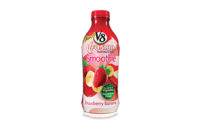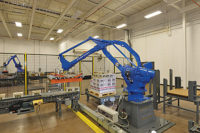In 1977, George Lucas introduced robots R2-D2 and C-3PO to the world in “Star Wars.” Thirty-one years later, Pixar Animation Studios released “WALL-E,” a computer-animated film about a trash-compacting robot. Although many Americans have fallen in love with the personalities of these fictional robots, today’s robots are more admired for their work ethic.
For instance, iRobot Corp. manufactures robots that can vacuum, wash floors, clean pools and clear gutters. Honda Motor Co. also released a robot in Europe that can mow lawns. In the beverage industry, robots can be used in production or warehouse spaces to increase efficiency and improve safety, among other benefits.
For instance, Greenville, S.C.-based Hartness International, a system integration partner of Rochester Hills, Mich.-based Fanuc Robotics, offers a robotic automated machine loading system that was developed to automatically load tray blanks, cartons, wrap-around blanks and RSC knock-downs into their given machine centers. By automating this area of the plant, customers are able to eliminate a high work force injury area while allowing operators to spend more time on value-added tasks within the line, such as quality audits, says Matthew Job, business unit manager of automation for Hartness International.
Robotics also are useful in repetitive processes, such as picking, that can be difficult or tiring for people.
“In the beverage industry, picking efficiency is greatly affected by the weight of the product,” explains Derek Rickard, distribution systems manager for RMT Robotics, Grimsby, Ontario. “Manual pickers are typically limited to one case at a time versus other industries with lighter products that allow pickers to grab several cases of each SKU when picking. Typically, the [return on investment] is greater for the beverage industry than in other food industries.”
Additionally, SKU proliferation has made manual picking more challenging as pickers are becoming less efficient and buildings are running out of storage space, he says. As a result, beverage distribution facilities are increasingly implementing robotics for improved operational efficiencies, ergonomic issues, traceability and reduced product damage and returns, he adds. RMT Robotics uses gantry robots to provide automated case and layer picking solutions for larger beverage warehouses.
“Our layer picking solution is of particular interest in the beverage industry as distributors are finding the SKU numbers and package types increasing, which limits the effectiveness of a fork truck attachment clamp device commonly used in beverage facilities,” Rickard says.
Recently, the company installed several tools for case and layer picking at Brewers Distributor Ltd., Calgary, Alberta. The fully automated picking system was designed to handle the distributor’s growing operational demands, which included high labor costs and low productivity associated with running a fully manual system, Rickard explains. Utilizing RMT’s
layer picking tool, the automation is able to handle a wide variety of packaging types, handling more than 250,000 cases a year while using two-thirds the footprint of the pre-existing manual system, he says.
In addition to picking, robotics can aid beverage facilities in many other applications. Some of the most common include layer forming, case packing, depalletizing, loading packaging material into cartoner magazines and palletizing, says Dick Motley, account manager for North American distribution with Fanuc Robotics.
“Palletizing is a classic, nasty ergonomics challenge, and a lot of times that’s the first implication that a new robotics user will implement just because they’re trying to solve a nasty ergonomics problem, and the technology’s so mature that they’re really comfortable with it,” Motley explains.
Robot acceptance
Companies’ use of robotic systems is becoming more prevalent, in part because these systems are more accepted in the marketplace now, Fanuc Robotics’ Motley says.
“There are enough successful examples out there that nobody feels like the guinea pig anymore,” he says. System integrators, such as Hartness International, Waterville, Ohio-based Kaufman Engineered Systems and Sarasota, Fla.-based KHS Inc., also are aiding in establishing robotics in the industry, he adds.
“There are system integrators out there who are focused on the needs of the beverage industry so they understand better what they’re trying to accomplish and can tailor the robotic solution to what they need in that industry,” Motley explains.
Earl Wohlrab, manager of robotic integration for Intelligrated, Mason, Ohio, adds that robots are becoming more established in the beverage industry for two reasons. “First, the pick-and-place speeds have advanced to the point that they are an economical choice for the higher-speed applications we see in the beverage world,” he explains. “Second, the proliferation of new packaging quantities and types require more dynamic and faster changeover times, both of which are better accomplished through robotics.”
As end-users continue to drive for more flexibility in products and package configurations, robotics continue to grow within the beverage industry, Hartness International’s Job adds.
“With the ability to provide a flexible solution to handle a wider range of products, package counts and packaging material, manufacturers are able to reduce time to market and able to take advantage of the newest trends in packaging,” he says.
For instance, many beverage-makers are launching products in light-weight bottles and eliminating the corrugate base in cases of product. In fact, Job says the light-weighting of bottles and package material has been the No. 1 driver in both development for new products and growth within the Hartness robotics group. The company’s standard high-speed palletizer was developed for the beverage industry to handle shrink-only bundles and low-gram polyethylene terephthalate (PET) bottles, he adds.
“This product has also grown into other areas of the business based on its low-level advantages, simple operator interface for adding new products and [being] one of the key factors of zero change time,” he explains.
New and noteworthy
Additionally, Hartness is in the process of launching a robotic decasing system to support the growing variety pack business. The new system will provide high throughput and flexibility to handle nearly any package configuration within a small footprint, Job says. The company also custom-designs robotic solutions for palletizing and packaging to meet customer needs, he adds.
One of RMT Robotics’ most notable products is its large-scale robotic gantry case picking system, which was built for use in a major warehouse automation project for one of North America’s largest beer distributors. The picking system is specifically designed to meet high-volume, high-SKU distribution demands, Rickard says.
“It orchestrates the activity of automated storage/retrieval systems (AS/RS), conveyor and multiple robotic gantries to systematically pick products in singles or groups and send them to the dock face in an optimized trailer load or palletizing sequence,” he explains.
Although this beer distributor required a large-scale system, Rickard says the company’s robotic solution can be scaled down for distribution operations that require a smaller footprint and seek a profitable alternative to manual or semi-automated case picking.
One of Intelligrated’s most popular offerings is its 950 series robotic hybrid palletizer, Wohlrab says. The product features a high-speed, in-line, conventional palletizing machine that uses a robotic arm for gentle handling and flexibility, which is ideal for small packages and complex patterns, he explains. The 950 series can perform at rates in excess of 125 cases a minute, he adds.
Recently, a Colorado brewer implemented Intelligrated’s 950 series robotic hybrid palletizer. It’s now the brewer’s most efficient and reliable palletizer among several other conventional palletizing machines, Wohlrab says.
Later this month, the company will unveil its 952-2 robotic palletizer with two robotic arms at Pack Expo. Intelligrated also offers other robotic solutions, such as depalletizers, case packers and tray loaders.
Fanuc Robotics launched new technologies this year, including the R-30iB controller. Used across the company’s product line, the R-30iB controller offers a new user interface with a full-color-graphics touchscreen, Web browsing that is compliant with Internet Explorer standards and energy-saving benefits.
“As the robot decelerates to rest, we’ll give some of that energy back to the grid, so that’s an optional functionality that’s available,” Motley says. “Then we do other smart things with the equivalent of turning the lights off when you’re not using them … turning cooling fans off, turning motors off, doing all different kinds of things to really focus on conserving energy.”
To optimize the speed of its robots, the company offers robot learning technology.
“You instrument the robot with an accelerometer and you run it through the path that it’s going to run in production, and through the accelerometer, it learns about the behavior of the whole arm and the tooling that’s attached,” Motley explains. “It learns about all that stuff and then automatically optimizes it.
“We’re just scratching the surface at this point, but that’s a pretty exciting part of R-30iB that’s going to help us get faster and faster and get more and more into some of these higher speed beverage applications and do those even more cost effectively,” he continues.
In-sight-full design
Fanuc Robotics also made improvements to its vision technology, which is built into the robot, as well as improved its safety technology.
The company made enhancements to interface with digital cameras and capabilities with higher resolution images and color images as well as expansion of its vision technology with this controller, it notes.
One of the key areas of focus in the next three to five years will be the use of vision-guided robots for tasks that might not currently be feasible with standard robotic solutions, Hartness International’s Job says. “Vision is already used in many applications, but as the tool has become more powerful and user-friendly, more customers are able to reap the benefits of adding the next dimension to flexible automation,” he says.
Fanuc Robotics also launched Delta robot technology, which are six-axis machines with dexterous wrists for enhanced movement. Most Delta robots are either a three- or four-axis device with simple movements, Motley says. Furthermore, Fanuc’s Delta robots feature a hollow center passage in the four-axis wrist for electrical lines.
“A lot of times, [robots are] pneumatically powered with an error line, and if you don’t have a hollow center passage to bring those utilities to the robot gripper, you have … a big service loop that whips around as the robot wrist bends and the tool spins around,” he explains. These movements can be damaging to the wiring. However, the hollow center passage protects the utilities within the robot, making it less prone to damage, Motley says.
Experts predict further growth for robotics in the beverage industry.
“We believe robotics in the warehouse will continue to grow as distributors look for more flexibility, better picking efficiency, less errors and a faster response time, ultimately offering better service to their customers,” RMT Robotics’ Rickard says. BI






